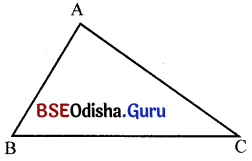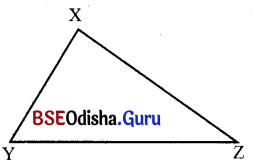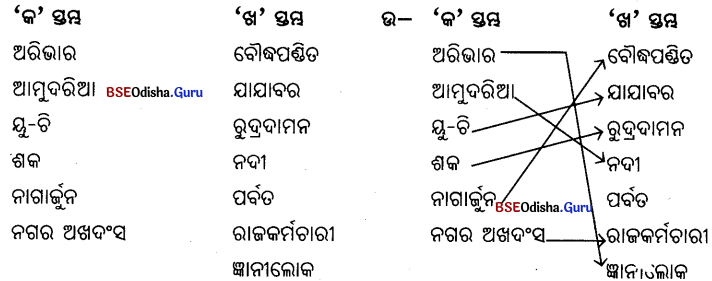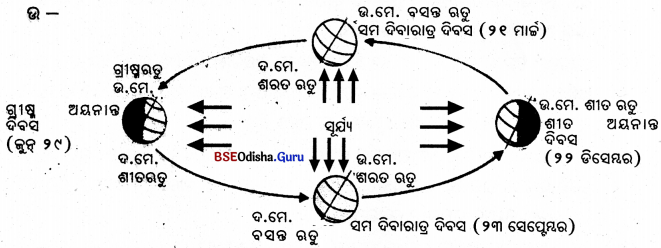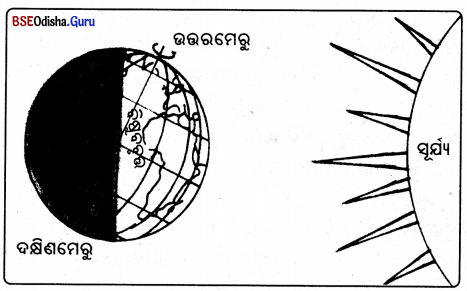Odisha State Board BSE Odisha 6th Class Political Science Important Questions Chapter 2 ରାଷ୍ଟ୍ର Important Questions and Answers.
BSE Odisha Class 6 Political Science Important Questions Chapter 2 ରାଷ୍ଟ୍ର
ପରୀକ୍ଷା ଉପଯୋଗୀ ଅତିରିକ୍ତ ପ୍ରଶ୍ନୋତ୍ତର
୧। ରାଷ୍ଟ୍ରଦ୍ୱାରା ପ୍ରତ୍ୟେକ ବ୍ୟକ୍ତିର କିପରି ଉପଯୁକ୍ତ ବିକାଶ ହୋଇଥାଏ ?
Answer:
- ରାଷ୍ଟ୍ରଦ୍ଵାରା ପ୍ରତ୍ୟେକ ବ୍ୟକ୍ତିର ଉପଯୁକ୍ତ ବିକାଶ ହୋଇଥାଏ । ସାଧାରଣ ବ୍ୟକ୍ତିମାନଙ୍କର ସର୍ବାଙ୍ଗୀନ ବିକାଶ ପାଇଁ ରାଷ୍ଟ୍ର ଅନେକଗୁଡ଼ିକଏ କଲ୍ୟାଣକାରୀ ଯୋଜନା ପ୍ରସ୍ତୁତ କରି କାର୍ଯ୍ୟକାରୀ କରିଥାଏ ।
- ସମୟ ପରିବର୍ତ୍ତନ ସହିତ ରାଷ୍ଟ୍ରର କାର୍ଯ୍ୟ କରିବାର ଢଙ୍ଗ ମଧ୍ୟ ପରିବର୍ତ୍ତନ ହୋଇଥାଏ ।
୨। ଆମ ସାମାଜିକ ଜୀବନରେ ରାଷ୍ଟ୍ରର ଭୂମିକା କିପରି ଖୁବ୍ ବେଶୀ ?
Answer:
- ଆମ ସାମାଜିକ ତଥାର ରାଜନୈତିକ ଅନୁଷ୍ଠାନ । ଏହା ଏକ ରାଜନୈତିକ ସଂଘ ।
- ମନୁଷ୍ୟ ଜନ୍ମ ହେଲାମାତ୍ରେ ନିଜକୁ ରାଷ୍ଟ୍ରର ସଭ୍ୟ ତାଲିକାରେ ସାମିଲ କରେ ।
୩। ପ୍ଲାଟୋ ଓ ଋଷୋଙ୍କ ମତରେ ରାଷ୍ଟ୍ରର ଜନସଂଖ୍ୟା କେତେକ ହେବା ଦରକାର ?
Answer:
- ପ୍ଲାଟୋଙ୍କ ମତରେ ରାଷ୍ଟ୍ରର ଜନସଂଖ୍ୟା ୫୦୪୦ ହେବା ଦରକାର ।
- ଋଷୋଙ୍କ ମତରେ ରାଷ୍ଟ୍ରର ଜନସଂଖ୍ୟା ୧୦, ୦୦୦ ହେବା ଦରକାର ।

୪। ‘ସାର୍ବଭୌମତ୍ୱ’ କେଉଁ ଶବ୍ଦରେ ଆସିଅଛି ? ଏହାର ଅର୍ଥ କ’ଣ ?
Answer:
- ସାର୍ବଭୌମତ ଲାଟିନ ଶବ୍ଦ ସପରନସର ଆସିଅଛି ।
- ଏହାର ଅର୍ଥ ହେଉଛି ସର୍ବୋଚ୍ଚ କ୍ଷମତା ।
୫। ବ୍ୟକ୍ତିର ସମ୍ପତ୍ତି ରାଷ୍ଟ୍ର ଗଠନ ପାଇଁ କିପରି ପ୍ରମୁଖ ଭୂମିକା ଗ୍ରହଣ କରିଥିଲା ?
Answer:
- ଯାଯାବର ଜୀବନ ତ୍ୟାଗକରି ମନୁଷ୍ୟ ଏକ ସମୟରେ ବ୍ୟକ୍ତିଗତ ସମ୍ପତ୍ତିର ମାଲିକ ହେଲା ।
- କ୍ରମେ ଜନସଂଖ୍ୟାର ବୃଦ୍ଧି ଫଳରେ ବ୍ୟକ୍ତିଗତ ସମ୍ପତ୍ତିର ସୁରକ୍ଷା ପାଇଁ ରାଷ୍ଟ୍ରର ଆବଶ୍ୟକତା ମନୁଷ୍ୟ ଉପଲବ୍ଧ କଲା । ତେଣୁ ରାଷ୍ଟ୍ରର କ୍ରମବିକାଶ ପାଇଁ ବ୍ୟକ୍ତିଗତ ସମ୍ପତ୍ତି ଏକ ଗୁରୁତ୍ଵପୂର୍ଣ୍ଣ ଭୂମିକା ଗ୍ରହଣ କରିଥିଲା ।
୬ | ଜନସଂଖ୍ୟା ବିନା ରାଷ୍ଟ୍ରର କଳ୍ପନା ଅସମ୍ଭବ କାହିଁକି ?
Answer:
- ରାଷ୍ଟ୍ରର ଗଠନ ପାଇଁ ଅଧିବାସୀ ଜନସଂଖ୍ୟା ଆବଶ୍ୟକ । କାରଣ ଜନମାନବ ଶୂନ୍ୟ ମରୁଭୂମି, ସାଗର ଓ ପଶୁମାନଙ୍କର ବାସସ୍ଥଳୀ ଜଙ୍ଗଲକୁ ରାଷ୍ଟ୍ର କୁହାଯାଇ ପାରିବ ନାହିଁ ।
- ଜନସଂଖ୍ୟାର କୌଣସି ନିର୍ଦ୍ଦିଷ୍ଟ ସୀମାନଥାଏ । ଏହା ଜନବହୁଳ ରାଷ୍ଟ୍ର କିମ୍ବା ଜନବିରଳ ରାଷ୍ଟ୍ର ହୋଇପାରେ । ତେଣୁ ପ୍ଲାଟୋଙ୍କ ମତରେ ରାଷ୍ଟ୍ରର ଜନସଂଖ୍ୟା ୫୦୪୦ ଓ ଋଷୋଙ୍କ ମତରେ ଏହା ୧୦, ୦୦୦ ଜନସଂଖ୍ୟା ବିଶିଷ୍ଟ ହେବା ଦରକାର ।
୭ | ‘ରାଷ୍ଟ୍ର’ କହିଲେ କ’ଣ ବୁଝ ? ରାଷ୍ଟ୍ରଦ୍ୱାରା ବ୍ୟକ୍ତିର କ’ଣ ହୋଇଥାଏ ?
Answer:
- ସବୁଠାରୁ ବଡ଼ କ୍ଷମତାଶାଳୀ ସାମାଜିକ ତଥା ରାଜନୈତିକ ଅନୁଷ୍ଠାନକୁ ରାଷ୍ଟ୍ର କୁହାଯାଏ ।
- ରାଷ୍ଟ୍ରଦ୍ୱାରା ବ୍ୟକ୍ତିର ଉପଯୁକ୍ତ ବିକାଶ ହୋଇଥାଏ ।
୮ | ରାଷ୍ଟ୍ରର କେତୋଟି ମୁଖ୍ୟ ଉପାଦାନ ରହିଛି ? ସେଗୁଡ଼ିକ କ’ଣ କ’ଣ ?
Answer:
- ରାଷ୍ଟ୍ରରେ ଚାରିଗୋଟି ମୁଖ୍ୟ ଉପାଦାନ ରହିଛି ।
- ସେଗୁଡ଼ିକ ହେଲା– ଜନସଂଖ୍ୟା, ଆୟତନ, ସରକାର ଓ ସାର୍ବଭୌମତ୍ୱ ।

୯। ସାର୍ବଭୌମତ୍ୱକୁ କେତେ ଭାଗରେ ବିଭକ୍ତ କରାଯାଇଛି ? ସେଗୁଡ଼ିକ କ’ଣ କ’ଣ ?
Answer:
- ସାର୍ବଭୌମତ୍ୱକୁ ଦୁଇ ଭାଗରେ ବିଭକ୍ତ କରାଯାଇଛି ।
- ସେଗୁଡ଼ିକ ହେଲା ଆଭ୍ୟନ୍ତରୀଣ ସାର୍ବଭୌମତ୍ଵ ଓ ବହିଃ ସାର୍ବଭୌମତ୍ୱ ।
୧୦ । ରାଷ୍ଟ୍ରର ଉତ୍ପତ୍ତି ବିଷୟରେ ଦୁଇଟି ତତ୍ତ୍ବ ଉଲ୍ଲେଖ କର ।
Answer:
- ରାଷ୍ଟ୍ର ଈଶ୍ଵର ବା ଭଗବାନଙ୍କ ଦ୍ବାରା ସୃଷ୍ଟି ହୋଇଛି– ଏହି ମତକୁ ଐଶ୍ଵରିକ ସୃଷ୍ଟିତତ୍ତ୍ଵ କହନ୍ତି ।
- ଯୁଦ୍ଧ ବା ଶକ୍ତିଦ୍ୱାରା ରାଷ୍ଟ୍ର ସୃଷ୍ଟି ହୋଇଛି । ଏହି ମତକୁ ଶକ୍ତିତତ୍ତ୍ୱ କୁହାଯାଏ ।
୧୧ । ‘ଗରିବ ରଥ’ କହିଲେ କ’ଣ ବୁଝ ?
Answer:
- ଯେଉଁ ଯାତ୍ରୀବାହୀ ରେଳଗାଡ଼ିରେ ସ୍ଵଳ୍ପ ମୂଲ୍ୟରେ ଶୀତତାପ ନିୟନ୍ତ୍ରଣରେ ସୁବିଧା ରହିଛି ତାକୁ ‘ଗରିବ ରଥ’ କ ହନ୍ତି ।
- ଏହା ସାଧାରଣତଃ ଗୋଟିଏ ରାଜ୍ୟର ରାଜଧାନୀରୁ ଅନ୍ୟ ଏକ ରାଜ୍ୟର ରାଜଧାନୀକୁ ଯାତାୟାତ କରିଥାଏ ।
୧୨ । ରାଷ୍ଟ୍ର ଗଠନ ପାଇଁ ଅଧିବାସୀ/ଜନସଂଖ୍ୟା କାହିଁକି ଆବଶ୍ୟକ ?
Answer:
- ରାଷ୍ଟ୍ର ଗଠନପାଇଁ ଜନସଂଖ୍ୟା ଆବଶ୍ୟକ । କାରଣ, ଜନ ମାନବଶୂନ୍ୟ ମରୁଭୂମି, ସାଗର ଓ ପଶୁମାନଙ୍କର ବାସସ୍ଥଳୀ ଜଙ୍ଗଲକୁ ରାଷ୍ଟ୍ର କୁହାଯାଇ ପାରିବ ନାହିଁ ।
- ଜନସଂଖ୍ୟା ବିନା ରାଷ୍ଟ୍ରର କଳ୍ପନା ଅସମ୍ଭବ ।
୧୩ । ସାର୍ବଭୌମତ୍ଵ (Sovereignty) କେଉଁ ଲାଟିନ୍ ଶବ୍ଦରୁ ଆସିଛି ? ଏହାର ଅର୍ଥ କ’ଣ ?
Answer:
- ସାର୍ବଭୌମତ୍ୱ ଲାଟିନ୍ ଶବ୍ଦ ସୁପର୍ନସ୍ତୁରୁ ଆସିଅଛି ।
- ଏହାର ଅର୍ଥ ହେଉଛି ସର୍ବୋଚ୍ଚ କ୍ଷମତା ।

୧୪ । ପିତୃଶାସିତ ଓ ମାତୃଶାସିତ ସିଦ୍ଧାନ୍ତ କାହାକୁ କୁହାଯାଏ ?
Answer:
- ପିତା ବା ମାତାଙ୍କ କର୍ତ୍ତୃତ୍ଵର ରୂପାନ୍ତରରେ ରାଷ୍ଟ୍ର ସୃଷ୍ଟି ହୋଇଛି ।
- ଏହି ମତକୁ ପିତୃଶାସିତ ଓ ମାତୃଶାସିତ ସିଦ୍ଧାନ୍ତ କୁହାଯାଏ ।
୧୫ । ରକ୍ତଗତ ସମ୍ପର୍କ କିପରି ରାଷ୍ଟ୍ରରେ ପରିଣତ ହୋଇଥିଲା ?
Answer:
- ରକ୍ତଗତ ସମ୍ପର୍କରୁ ପରିବାର ବୃଦ୍ଧି ଏବଂ କାଳକ୍ରମେ ବଂଶ ଓ ଗୋଷ୍ଠୀର ଉତ୍ପତ୍ତି ହୋଇଛି । ସେହି ଗୋଷ୍ଠୀ ଶେଷରେ ରାଷ୍ଟ୍ରରେ ପରିଣତ ହୋଇଥିଲା ।
- ସେହି ଗୋଷ୍ଠୀ ଶେଷରେ ରାଷ୍ଟ୍ରରେ ପରିଣତ ହୋଇଥିଲା ।
ଅତି ସଂକ୍ଷିପ୍ତ ଉତ୍ତରମୂଳକ ପ୍ରଶ୍ନୋତ୍ତର
୧। ‘ଶକ୍ତିତ’ କାହାକୁ କୁହାଯାଏ ?
Answer:
ଯୁଦ୍ଧଦ୍ୱାରା ରାଷ୍ଟ୍ର ସୃଷ୍ଟି ମତବାଦକୁ ଶକ୍ତିତତ୍ତ୍ୱ କୁହାଯାଏ ।
୨। ବଂଶରୁ କ’ଣ ସୃଷ୍ଟି ହୋଇଥିଲା ?
Answer:
ବଂଶରୁ ଗୋଷ୍ଠୀ ସୃଷ୍ଟି ହୋଇଥିଲା ।
୩। ହିନ୍ଦୁ ଧର୍ମର କେଉଁ ବହିରେ ଭଗବାନଙ୍କଦ୍ୱାରା ରାଷ୍ଟ୍ର ସୃଷ୍ଟି ହୋଇଛି ବୋଲି କୁହାଯାଇଛି ?
Answer:
ହିନ୍ଦୁ ଧର୍ମର ‘ମନୁସ୍ମୃତି’ ଓ ‘ମହାଭାରତ’ରେ ଭଗବାନଙ୍କଦ୍ୱାରା ରାଷ୍ଟ୍ର ସୃଷ୍ଟି ହୋଇଛି ବୋଲି କୁହାଯାଇଛି ।
୪। ପ୍ଲାଟୋଙ୍କ ମତରେ ରାଷ୍ଟ୍ରର ଜନସଂଖ୍ୟା ୫୦୪୦ ହେବା ଦରକାର ।
Answer:
ପ୍ଲାଟୋଙ୍କ ମତରେ ରାଷ୍ଟ୍ରର ଜନସଂଖ୍ୟା ୫୦୪୦ ହେବା ଦରକାର ।

୫। ଭଗବାନଙ୍କଦ୍ୱାରା ରାଷ୍ଟ୍ର ସୃଷ୍ଟି ହୋଇଛି – ଏହି ମତକୁ କ’ଣ କୁହାଯାଏ ?
Answer:
ଭଗବାନଙ୍କଦ୍ୱାରା ରାଷ୍ଟ୍ର ସୃଷ୍ଟି ହୋଇଛି – ଏହି ମତକୁ ଐଶ୍ୱରୀକ ସୃଷ୍ଟି ତତ୍ତ୍ବ କୁହାଯାଏ ।
୬ । କିଏ ରାଜନୀତି ବିଜ୍ଞାନର ମୁଖ୍ୟ ବିଷୟବସ୍ତୁ ଓ କେନ୍ଦ୍ରବିନ୍ଦୁ ?
Answer:
ରାଷ୍ଟ୍ର ରାଜନୀତି ବିଜ୍ଞାନର ମୁଖ୍ୟ ବିଷୟବସ୍ତୁ ଓ କେନ୍ଦ୍ରବିନ୍ଦୁ ।
୭ | ରାଷ୍ଟ୍ରର କାର୍ଯ୍ୟକୁ କେତେ ଭାଗରେ ବିଭକ୍ତ କରାଯାଇଛି ଓ କ’ଣ କ’ଣ ?
Answer:
ରାଷ୍ଟ୍ରର କାର୍ଯ୍ୟକୁ ୨ ଭାଗରେ ବିଭକ୍ତ କରାଯାଇଛି; ଯଥା – (୧) ବାଧ୍ୟତାମୂଳକ ଓ (୨) ଇଚ୍ଛାଧୀନ ।
୮ | ରାଷ୍ଟ୍ର କିପରି ସୃଷ୍ଟି ହୋଇଛି ?
Answer:
ରାଷ୍ଟ୍ର ଈଶ୍ବର, ଶକ୍ତି, ସାମାଜିକ ଚୁକ୍ତି, ପିତାମାତାଙ୍କ କର୍ତ୍ତୃତ୍ଵ ଓ କ୍ରମ ବିବର୍ତ୍ତନଦ୍ୱାରା ସୃଷ୍ଟି ହୋଇଛି ବୋଲି କୁହାଯାଏ ।
୯ । ରୁଷୋଙ୍କ ମତରେ ରାଷ୍ଟ୍ରର ଜନସଂଖ୍ୟା କେତେ ହେବା ଦରକାର ?
Answer:
ରୁଷୋଙ୍କ ମତରେ ରାଷ୍ଟ୍ରର ଜନସଂଖ୍ୟା ୧୦,୦୦୦ ହେବା ଦରକାର । ୧୦ । ଦୁଇଟି ଜନବିରଳ ରାଷ୍ଟ୍ରର ନାମ ଲେଖ ।
୧୦ । ଦୁଇଟି ଜନବିରଳ ରାଷ୍ଟ୍ରର ନାମ ଲେଖ ।
Answer:
ଦୁଇଟି ଜନବିରଳ ରାଷ୍ଟ୍ରର ନାମ ମୋନାକୋ, ସାନ୍ମାରିନୋ ।
୧୧। ଦୁଇଟି ଜନବହୁଳ ରାଷ୍ଟ୍ରର ନାମ ଲେଖ ।
Answer:
ଦୁଇଟି ଜନବହୁଳ ରାଷ୍ଟ୍ରର ନାମ ଚୀନ୍ ଓ ଭାରତ ।

୧୨ । କାହାଦ୍ଵାରା ରାଷ୍ଟ୍ରର ବାସ୍ତବ ରୂପ ପ୍ରକାଶ ପାଇଥାଏ ।
Answer:
ସରକାରଙ୍କଦ୍ବାରା ରାଷ୍ଟ୍ରର ବାସ୍ତବ ରୂପ ପ୍ରକାଶ ପାଇଥାଏ ।
୧୩ । ସରକାର ନ ଥିଲେ ରାଷ୍ଟ୍ରର କି କ୍ଷତି ଘଟନ୍ତା ?
Answer:
ସରକାର ନ ଥିଲେ ଅରାଜକତା ସୃଷ୍ଟି ହୋଇ ରାଷ୍ଟ୍ର ତଥା ସମାଜ ଓ ବ୍ୟକ୍ତିର ସ୍ଥିତିରେ ବିପନ୍ନ ଘଟନ୍ତା ।
୧୪ । କେତେବେଳେ ଗୋଟିଏ ନିର୍ଦ୍ଦିଷ୍ଟ ଭୂଭାଗକୁ ରାଷ୍ଟ୍ର କୁହାଯିବ ନାହିଁ ?
Answer:
ଗୋଟିଏ ନିର୍ଦ୍ଦିଷ୍ଟ ଭୂଭାଗରେ ଅସ୍ଵାସୀ ରହିଥିଲେ ମଧ୍ୟ ସରକାର ନ ଥିଲେ ତାକୁ ରାଷ୍ଟ୍ର ବୋଲି କୁହାଯାଇପାରିବ ନାହିଁ ।
୧୫ । ସରକାର କ’ଣ ?
Answer:
ସରକାର ଏକ ରାଜନୈତିକ ସଙ୍ଗଠନ ।
୧୬ । ରାଷ୍ଟ୍ରର ସବୁଠାରୁ ବଡ଼ କ୍ଷମତା କ’ଣ ?
Answer:
ରାଷ୍ଟ୍ରର ସବୁଠାରୁ ବଡ଼ କ୍ଷମତା ସାର୍ବଭୌମତ୍ୱ ।
୧୭ । ସାର୍ବଭୌମତ୍ଵର ଅର୍ଥ କ’ଣ ?
Answer:
ସାର୍ବଭୌମତ୍ୱ ଲାଟିନ୍ ଶବ୍ଦ ‘ସୁପର୍ନସ୍’ରୁ ଆସିଅଛି, ଯାହାର ଅର୍ଥ ସର୍ବୋଚ୍ଚ କ୍ଷମତା ।
୧୮। ରାଷ୍ଟ୍ରର ଇଚ୍ଛାଧୀନ କାର୍ଯ୍ୟ କାହାକୁ କୁହାଯାଏ ?
Answer:
ଯେଉଁ କାର୍ଯ୍ୟଗୁଡ଼ିକ ଜନସାଧାରଣଙ୍କ କଲ୍ୟାଣପାଇଁ ଉଦ୍ଦିଷ୍ଟ ତାକୁ ରାଷ୍ଟ୍ରର ଇଚ୍ଛାଧୀନ କାର୍ଯ୍ୟ କୁହାଯାଏ ।

୧୯ । ସାମାଜିକ ଚୁକ୍ତି ମତବାଦ କାହାକୁ କୁହାଯାଏ ?
Answer:
ମନୁଷ୍ୟ ଚୁକ୍ତି କରି ରାଷ୍ଟ୍ର ସୃଷ୍ଟି କରିଅଛି । ଏହି ମତକୁ ସାମାଜିକ ମତବାଦ କୁହାଯାଏ ।
୨୦ । କେଉଁମାନେ ସାମାଜିକ ଚୁକ୍ତି ମତବାଦର ସମର୍ଥକ ଅଟନ୍ତି ?
Answer:
ଇଂରେଜ ଦାର୍ଶନିକ ହବସ୍, ଲକ୍ ଓ ଫରାସୀ ଦାର୍ଶନିକ ରୁଷୋ ସାମାଜିକ ଚୁକ୍ତି ମତବାଦର ସମର୍ଥକ ଅଟନ୍ତି ।
୨୧ । ରାଷ୍ଟ୍ରର ଉତ୍ପତ୍ତି କିପରି ହୋଇଛି ?
Answer:
ପରିବାରରୁ ବଂଶ ଓ ବଂଶରୁ ଗୋଷ୍ଠୀ ସୃଷ୍ଟି ହୋଇଥିଲା ଓ ଏହି ଗୋଷ୍ଠୀରୁ ରାଷ୍ଟ୍ରର ଉତ୍ପତ୍ତି ହୋଇଛି ।
୨୨ । ରାଷ୍ଟ୍ରର ଉତ୍ପତ୍ତି ସମ୍ବନ୍ଧରେ ପ୍ରାଚୀନ ମତ କ’ଣ ?
Answer:
ରାଷ୍ଟ୍ରର ଉତ୍ପତ୍ତି ସମ୍ବନ୍ଧରେ ପ୍ରାଚୀନ ମତ ହେଲା – ରାଷ୍ଟ୍ର ଈଶ୍ଵରଙ୍କ ଦ୍ୱାରା ସୃଷ୍ଟି ହୋଇଛି ଓ ଏହାକୁ ଶାସନ କରିବାପାଇଁ ଈଶ୍ବର ରାଜାଙ୍କୁ ପଠାଇଛନ୍ତି ।
୨୩ । ରାଷ୍ଟ୍ରର ସୃଷ୍ଟି ସମ୍ବନ୍ଧରେ ଆରିଷ୍ଟୋଟଲଙ୍କ ମତ କ’ଣ ?
Answer:
ଆରିଷ୍ଟୋଟଲ୍ଙ୍କ ମତରେ ପରିବାର ଓ ଗ୍ରାମମାନଙ୍କର ସମଷ୍ଟିରେ ରାଷ୍ଟ୍ର ସୃଷ୍ଟି ହୋଇଛି ।
ବସ୍ତୁନିଷ୍ଠ ପ୍ରଶ୍ନୋତ୍ତର
୧ । ବନ୍ଧନୀ ମଧ୍ଯରୁ ଉପଯୁକ୍ତ ଶବ୍ଦ ବାଛି ଶୂନ୍ୟସ୍ଥାନ ପୂରଣ କର ।
(ଗୋଷ୍ଠୀ, ସାନ୍ମାରିନୋ ମନୁସୃତି ଓ ମହାଭାରତ, ଶକ୍ତିତତ୍ତ୍ବ, ଦୁଇ, ତିନି, ରାଷ୍ଟ୍ର, ପରିବାର)
(କ) ଯୁଦ୍ଧଦ୍ୱାରା ରାଷ୍ଟ୍ର ସୃଷ୍ଟି ମତବାଦକୁ ______________ କୁହାଯାଏ ।
Answer:
ଶକ୍ତିତତ୍ତ୍ୱ

(ଖ) ସାର୍ବଭୌମତ୍ୱକୁ _________________ ଭାଗରେ ବିଭକ୍ତ କରାଯାଇଛି ।
Answer:
ଦୁଇ
(ଗ) ବଶରୁ __________________ ସୃଷ୍ଟି ହୋଇଥିଲା ।
Answer:
ଗୋଷ୍ଠୀ
(ଘ) ହିଦୁ ଧର୍ମର _________________ ରେ ଭଗବାନଙ୍କଦ୍ୱାରା ରାଷ୍ଟ୍ର ସୃଷ୍ଟି ହୋଇଛି ବୋଲି କୁହାଯାଇଛି
Answer:
ମନୁସ୍ମୃତି ଓ ମହାଭାରତ
(ଡ) ଗୋଟିଏ ନିର୍ଦ୍ଦିଷ୍ଟ ଭୂଭାଗରେ ଅସ୍ଵାସୀ ରହିଥିଲେ ମଧ୍ୟ ସରକାର ନଥିଲେ ତାକୁ ________________ କୁହାଯାଇପାରିବ ନାହିଁ ।
Answer:
ରାଷ୍ଟ୍ର
(ଚ) _______________ ଏକ ଜନବିରଳ ରାଷ୍ଟ୍ର ।
Answer:
ସାନ୍ମାରିନୋ
(ଛ) ରାଷ୍ଟ୍ରର କ୍ରମ ବିକାଶରେ _______________ ର ଭୂମିକା ଗୁରୁତ୍ଵପୂର୍ଣ୍ଣ ।
Answer:
ପରିବାର

୨। ନିମ୍ନରେ ପ୍ରତ୍ୟେକ ପ୍ରଶ୍ନ ତଳେ ଚାରିଗୋଟି ସମ୍ଭାବ୍ୟ ଉତ୍ତର ଦିଆଯାଇଛି । ସେଥୁମଧ୍ୟରୁ ଠିକ୍ ଉତ୍ତର ପାଖ କୋଠରିରେ (✓) ହିଁ ଚିହ୍ନ ଦିଅ । (ପ୍ରଶ୍ନ ସହ ଉତ୍ତର)
(କ) ‘ଭଗବାନଙ୍କଦ୍ୱାରା ରାଷ୍ଟ୍ର ସୃଷ୍ଟି ହୋଇଛି’ – ଏହି ମତକୁ କ’ଣ କୁହାଯାଏ
(୧) ଶକ୍ତି ତତ୍ତ୍ବ
(୨) ପିତୃଶାସିତ ସିଦ୍ଧାନ୍ତ
(୩) ସାମାଜିକ ଚୁକ୍ତି ମତବାଦ
(୪) ଐଶ୍ଵରିକ ସୃଷ୍ଟି ମତବାଦ
Answer:
(୪) ଐଶ୍ଵରିକ ସୃଷ୍ଟି ମତବାଦ
(ଖ) ନିମ୍ନୋକ୍ତ ମଧ୍ୟରୁ କେଉଁଟି ଏକ ସେବା ସଂଘ ?
(୧) କର୍ମଚାରୀ ସଂଘ
(୨) ବଣିକ ସଂଘ
(୩) ଭାରତ ସେବାଶ୍ରମ
(୪) ବୌଦ୍ଧ ସଂଘ
Answer:
(୩) ଭାରତ ସେବାଶ୍ରମ
(ଗ) ପ୍ଲାଟୋଙ୍କ ମତରେ ରାଷ୍ଟ୍ରର ଜନସଂଖ୍ୟା କେତେ ହେବା ଦରକାର ?
(୧) ୧୦,୦୦୦
(୨) ୪,୦୦୦
(୩) ୫୦୦୦
(୪) ୫୦୪୦
Answer:
(୪) ୫୦୪୦
(ଘ) ନିମ୍ନୋକ୍ତ ମଧ୍ୟରୁ କେଉଁ ଦାର୍ଶନିକ ସାମାଜିକ ଚୁକ୍ତି ମତବାଦର ସମର୍ଥକ ଅଟନ୍ତି ?
(୧) ଆରିଷ୍ଟୋଟଲ୍
(୨) ପ୍ଲାଟୋ
(୩) ଲକ୍
(୪) ଖାରନର
Answer:
(୩) ଲକ୍

(ଙ) ନିମ୍ନୋକ୍ତ ମଧ୍ୟରୁ କେଉଁଟି ରାଷ୍ଟ୍ରର ବାଧ୍ୟତାମୂଳକ କାର୍ଯ୍ୟ ?
(୧) ଦେଶର ସ୍ୱାଧୀନତାର ସୁରକ୍ଷା
(୨) ଗମନାଗମନ ବ୍ୟବସ୍ଥା ପରିଚାଳନା
(୩) ବରିଷ୍ଠ ନାଗରିକଙ୍କ ସାମାଜିକ ସୁରକ୍ଷା
(୪) ଖାଉଟି ଦ୍ରବ୍ୟ ଯୋଗାଣ
Answer:
(୧) ଦେଶର ସ୍ୱାଧୀନତାର ସୁରକ୍ଷା
![]()
![]()


